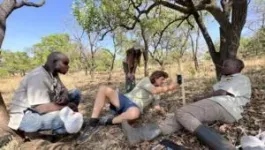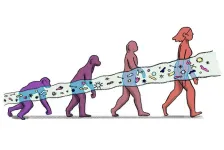(Press-News.org) CHICAGO – A minimally invasive procedure provides significant relief from knee pain and may prevent the need for knee replacement surgery in people with osteoarthritis, according to a study being presented this week at the annual meeting of the Radiological Society of North America (RSNA).
“This study addresses osteoarthritis, which is a significant public health issue and the leading cause of chronic pain and disability worldwide,” said the study’s lead author, Florian Nima Fleckenstein, M.D., interventional radiologist at Charité – University Hospital Berlin in Germany. “With millions of people affected by knee osteoarthritis, particularly in aging populations, finding effective, minimally invasive treatments is critical.”
Osteoarthritis, a chronic, degenerative and progressive condition, is the most common cause of chronic joint disorders. According to the World Health Organization, knee osteoarthritis affects over 365 million adults worldwide.
Most available therapies, such as pain medication and steroid injections, only mask the symptoms of osteoarthritis. They don’t slow progression of the disease. As osteoarthritis worsens and conservative treatments become ineffective, many people turn to joint replacement surgery.
Genicular artery embolization (GAE) is an innovative minimally invasive therapy for patients with symptomatic knee osteoarthritis. The genicular arteries have several branches that form a network around the knee joint. These vessels are altered in patients suffering from osteoarthritis. In GAE, an interventional radiologist injects small particles into selected branches that correspond to the site of knee pain to block blood flow to that area. Embolization of the abnormal blood vessels helps to disrupt the cycle of inflammation, cartilage destruction and sensory nerve growth that characterizes osteoarthritis.
For the study, Dr. Fleckenstein and colleagues conducted a retrospective analysis of 403 cases from patients (age 40 to 90) with moderate to severe knee osteoarthritis that didn’t respond to conservative treatments. All patients underwent GAE at the Charité – University Hospital Berlin. The study was designed to evaluate both the safety and efficacy of GAE across a broad spectrum of osteoarthritis severities. The effectiveness of the procedure was measured using the Visual Analog Scale and the Knee Injury and Osteoarthritis Outcome Score. These standardized scores, which measure pain and quality of life, were recorded at baseline and during follow-up visits at six weeks, three months, six months and one-year post-procedure.
Technical success was achieved in 100% of procedures. Temporary slight skin discoloration and mild knee pain immediately after the procedure were noted in 18% of all cases. No severe complications were reported. The quality-of-life index and pain score improved by 87% and 71%, respectively, at one-year follow-up.
The findings show that GAE is a safe and effective treatment option across all severity grades of knee osteoarthritis, including advanced cases where other treatments have very limited efficacy.
“Our study found that GAE can effectively reduce knee pain and improve quality of life early after the treatment, with these benefits being maintained over the long term, especially for people who haven’t had success with other treatments like physical therapy or pain medications,” Dr. Fleckenstein said. “This could potentially offer a new lease on life for many patients who suffer from debilitating pain and mobility issues, caused by osteoarthritis.”
However, the study also showed that GAE is particularly effective in the early stages of knee osteoarthritis. This indicates that early intervention could potentially delay or even prevent disease progression, reducing the need for more invasive treatments, such as surgery.
The researchers hope that by demonstrating the procedure’s success in a large and diverse patient population, the study could influence medical practice and policy, encouraging broader adoption of GAE in clinical settings worldwide.
“GAE has the potential to reduce the need for more invasive surgeries, lower health care costs and significantly improve the quality of life for countless individuals suffering from knee osteoarthritis,” Dr. Fleckenstein said.
He and his team plan to continue their research on degenerative joint disorders to provide patients with new options in the field of interventional radiology.
Co-authors are Timo Alexander Auer, M.D., Bernd Hamm, M.D., Bernhard Gebauer, M.D., and Federico Collettini, M.D. This study was awarded the RSNA Trainee Research Prize.
###
Note: Copies of RSNA 2024 news releases and electronic images will be available online at RSNA.org/press24.
RSNA is an association of radiologists, radiation oncologists, medical physicists and related scientists promoting excellence in patient care and health care delivery through education, research and technologic innovation. The Society is based in Oak Brook, Illinois. (RSNA.org)
For patient-friendly information on interventional radiology, visit RadiologyInfo.org.
END
A group of scientists, including researchers from Rutgers University-New Brunswick, Princeton University and Carleton University, has questioned the accuracy and utility of the metaphor “tipping point” in calling attention to the threat of climate change.
The phrase, while perhaps initially useful as a clarion call that warns about sudden, drastic changes, may now be confusing the public and impeding action, researchers said.
Writing a perspective in Nature Climate Change, the scientists, from the Rutgers Climate and Energy Institute, Princeton’s Center ...
Plant species can fulfil different functions within an ecosystem, even if they are closely related to each other. This surprising conclusion was reached by a global analysis of around 1.7 million datasets on plant communities. The study was led by Martin Luther University Halle-Wittenberg (MLU) and the University of Bologna. Their findings overturn previous assumptions in ecology. The study was published in "Nature Ecology & Evolution" and offers insights for nature conservation.
When ...
Specially packaged DNA secreted by tumor cells can trigger an immune response that inhibits the metastatic spread of the tumor to the liver, according to a study led by researchers at Weill Cornell Medicine, Memorial Sloan Kettering Cancer Center and Korea’s Yonsei University. The discovery improves the scientific understanding of cancer progression and anticancer immunity, and could yield new clinical tools for assessing and reducing metastasis risk.
In the study, reported Dec. 3 in Nature Cancer, the researchers examined cancer cells’ secretion of short stretches of DNA packaged on tiny capsules called extracellular ...
The first summer on record that melts practically all of the Arctic’s sea ice, an ominous milestone for the planet, could occur as early as 2027.
For the first time, an international research team, including University of Colorado Boulder climatologist Alexandra Jahn and Céline Heuzé from the University of Gothenburg in Sweden, used computer models to predict when the first ice-free day could occur in the northernmost ocean. An ice-free Arctic could significantly impact the ecosystem and Earth’s climate by changing weather patterns.
“The first ice-free day in the Arctic won’t change things dramatically,” ...
Lion numbers in the country are at a critical low while hyenas are faring well across four major protected areas in Uganda, according to new survey findings co-led by Griffith University, Southern University of Science and Technology (China) and Northern Arizona University.
Researchers unveiled the first comprehensive population estimate of Uganda’s lions, leopards, and spotted hyenas in nearly two decades.
Conducted across six major protected areas – including the 4000 km2 Murchison Falls and the 2400 km2 Queen Elizabeth Conservation Area – this innovative study was a collaborative ...
Leuven, 3 December 2024 – Alzheimer’s disease is a debilitating condition that slowly robs people of their memory and cognitive abilities, affecting millions of people worldwide. Familial Alzheimer’s disease (FAD), a rare inherited form of the disease, is linked to mutations in several genes, including APP, PSEN1, and PSEN2. The impact of PSEN2 mutations has remained less understood—until now. A research team led by Prof. Wim Annaert at VIB-KU Leuven has shed light on how mutated PSEN2 accelerates disease ...
A 10-minute brain scan can predict the effectiveness of a risky spinal surgery to alleviate intractable pain. The Kobe University result gives doctors a much-needed biomarker to discuss with patients considering spinal cord stimulation.
For patients with chronic pain that cannot be cured in any other way, a surgical procedure called “spinal cord stimulation” is seen as a method of last resort. The treatment works by implanting leads into the spine of patients and electrically stimulating the spinal cord. Because the spinal cord transmits sensations to the brain from all over the body, the position ...
The risk of developing dementia later in life is strongly predicted by a person’s cognitive ability, functional limitations and physical health as many as 20 years before onset of the illness, according to a new RAND report.
Related new research found that early detection of cognitive impairment helps people to take mitigating actions to prepare for future loss of financial and physical independence.
While older adults’ take-up of cognitive testing currently is low, additional research found that use of cognitive tests would increase if it was free and readily accessible, ...
COLUMBUS, Ohio – Some say the holidays are the most wonderful time of the year. But for others, the hectic holiday season may be the most stressful.
A new national survey of 1,000 Americans commissioned by The Ohio State University Wexner Medical Center and College of Medicine shows that 46% of Americans say they don’t get the alone time they need during the holidays.
In addition, 56% of survey respondents say that it’s very important to their mental health to have adequate alone time.
Sophie Lazarus, PhD, a clinical psychologist in the Department of Psychiatry and Behavioral Health at Ohio State, says in ...
How did human brains get so big? The answer could be in our gut
Microbes supporting the production of more metabolic energy could be key to the evolution of large brains
First study to show gut microbes from different animal species shape variations in their biology
Offers new take on human evolution, particularly the evolution of our large brains
Mice with large-brain primate microbes eat more, but grew slower and put on less body fat
Their bodies use the excess energy to produce high levels of glucose, which is the brain’s primary ...








